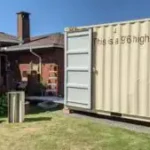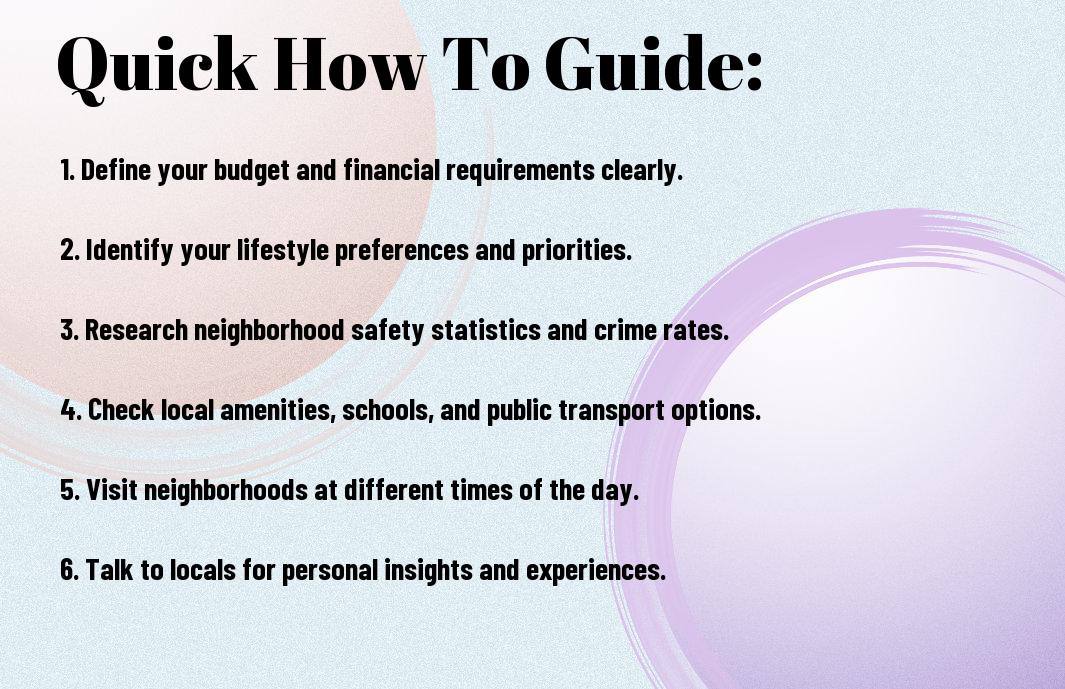First-time homebuyers often face the challenge of selecting the right neighborhood that aligns with their lifestyle and budget. To simplify this process, you need to consider various factors such as safety, school quality, amenities, and distance to work. Engaging with locals and conducting thorough research will enhance your understanding of the area. If you’re unsure where to begin, check out this discussion on How do you choose a neighborhood when buying? for insightful tips from others in your shoes.
Key Takeaways:
- Assess your lifestyle needs, such as proximity to work, schools, and recreational facilities, to find a neighborhood that aligns with your daily activities.
- Research local amenities, safety statistics, and community resources to ensure the area meets your expectations for comfort and convenience.
- Consider future market trends and development plans in the neighborhood to make informed decisions about potential property value appreciation.
Understanding Your Needs
The first step in selecting the right neighborhood as a first-time buyer involves understanding your unique needs and preferences. Taking the time to identify what matters most to you will ensure a smoother transition into your new home. Different neighborhoods cater to various demographics, lifestyles, and amenities, so clear self-assessment will help you narrow down your options effectively. Consider aspects such as proximity to work, schools, and recreational areas, as well as the overall atmosphere and character of the community that resonates with you.
Determine Your Budget
With an array of neighborhoods available, establishing your budget is vital in guiding your decisions. Take into account your financial situation, including your monthly income, savings, and any debts you may have. Make a realistic assessment of how much you can comfortably afford to invest in housing without compromising your financial stability. Don’t forget to factor in additional costs such as property taxes, homeowners insurance, and maintenance fees, which can significantly impact your overall budget.
Identify Your Lifestyle Preferences
Little things can make a big difference when choosing the right neighborhood. You should assess your lifestyle preferences, as they align closely with what you envision for your future living environment. Consider whether you prefer an urban setting with vibrant nightlife and dining options, or perhaps a quieter suburban atmosphere with parks and family-friendly amenities. Pay attention to the types of activities and services that are important to you, such as access to public transportation, grocery stores, fitness centers, and community events.
Understanding your lifestyle preferences can provide critical insight into how well a neighborhood will suit your daily routine and long-term happiness. For example, if you thrive in a culturally rich environment with numerous entertainment options, seek areas known for their vibrant arts scene or active community events. Alternatively, if serenity and outdoor activities are what you seek, then neighborhoods near parks, trails, or waterfronts should be prioritized. By aligning your lifestyle with the neighborhood’s offerings, you can enhance your overall living experience.
Key Factors to Consider
You must prioritize key aspects when selecting the right neighborhood as a first-time buyer. These factors will not only impact your immediate comfort but also the long-term value of your investment. Begin with considerations like proximity to work, available amenities, and overall community vibe. It’s wise to assess public transportation options, local parks, shopping areas, and restaurants. Create a checklist to help you weigh these features against your lifestyle preferences and needs:
- Proximity to work or schools
- Available amenities (grocery stores, parks, restaurants)
- Safety and crime rates
- School district quality
- Future development plans
Assume that investing time in evaluating these factors will yield a more satisfying home-buying experience. For more guidance, check out this resource on Buying Your First Home? How to Pick the Best Neighborhood for You.
Safety and Crime Rates
To ensure a comfortable living environment, it’s important to investigate the safety and crime rates of potential neighborhoods. You can find crime statistics through local police department websites or by consulting community safety resources. A neighborhood’s reputation for safety can significantly influence your quality of life. By checking crime reports, you can gain insights into which areas are bustling with families and community-minded individuals and which ones may be on the upswing or experiencing challenges. You should also consider talking to local residents to get a feel for their experiences.
School District Quality
Safety in a neighborhood often correlates with the quality of its school district. Families typically look for neighborhoods in high-rated school districts, influencing both property values and the community environment. Areas with reputable schools often have higher demand, making them attractive to potential buyers. When researching school district quality, look for factors such as academic performance, extracurricular offerings, and school facilities.
School performance metrics can be a vital asset in your decision-making process. Investigating not only the overall ratings but also specific programs offered can impact your choice—whether or not you have children. Schools with solid reputations attract families, fostering a sense of community and stability. Thus, prioritizing educational quality will benefit your family and your property long-term.
Accessibility and Transportation
Many factors contribute to your overall living experience in a neighborhood, and accessibility and transportation options can significantly impact your lifestyle as a first-time homebuyer. Evaluating how easily you can reach your workplace and nearby amenities can save you time and improve your daily routines. When considering a neighborhood, pay attention to the distance to your job, grocery stores, schools, and healthcare facilities, as well as the overall walkability of the area. A neighborhood that allows you to complete errands without much hassle can greatly enhance your quality of life.
Proximity to Work and Amenities
Little adjustments in your daily commute can lead to influential changes in your overall satisfaction. Ideally, you’ll want to find a neighborhood that minimizes your travel time to work while providing easy access to your vital amenities. Look for neighborhoods where you can enjoy parks, coffee shops, and grocery stores all within a short drive or even walking distance. This not only allows for convenience but can also foster a sense of community, as you become familiar with local businesses and engage with your neighbors over time.
Public Transportation Options
Little attention to available public transportation options can limit your choices when selecting a neighborhood. Many first-time buyers may overlook the benefits of nearby transit services. If your work schedule involves commuting, having public transportation within reach can be a great advantage, allowing you to avoid the stresses of driving in heavy traffic and finding parking. Knowing the frequency and reliability of bus or train services can contribute to your decision, offering flexibility and potential cost savings on transportation expenses.
A key aspect to consider when evaluating public transportation options is accessibility to major transit routes and hubs. Research the types of transit systems available, such as buses, subways, or commuter trains, and how well they connect to your workplace and other important destinations. Additionally, take a look at timetables and peak service hours to ensure you have options that fit your lifestyle. Understanding this can help position you in a neighborhood that not only simplifies your daily commute but also connects you easily to various parts of the city for leisure and social activities.
Neighborhood Features
Your choice of neighborhood should be influenced by the features that can enhance your lifestyle and well-being. From parks and recreation facilities to local attractions and community events, these elements contribute to the overall appeal of a neighborhood. As you weigh your options, consider how these features align with your daily routine, interests, and long-term goals as a first-time buyer. A neighborhood rich in amenities can make your new home feel more connected to the community and enhance your experience as a resident.
Parks and Recreation Facilities
To evaluate the parks and recreation facilities in an area, you should investigate the types of green spaces available and how often you plan to utilize them. Parks provide a venue for family outings, exercise, and social gatherings, which can be significant for your lifestyle. Additionally, recreational facilities like sports fields, gyms, and community centers can cater to your fitness needs and social interests, making it easier to engage with your neighbors and meet new friends.
Local Attractions and Community Events
With local attractions and community events, you can enjoy a vibrant social life that complements your home. Take the time to explore museums, theaters, farmers’ markets, and local shops within the neighborhood to understand what draws people to the area. Engaging events such as festivals, fairs, and seasonal activities can not only enrich your living experience but also foster a sense of belonging within the community.
Community events serve as connective tissue for residents, offering opportunities to build relationships and create shared memories. These gatherings often reflect the interests and diversity of the neighborhood, showcasing everything from local artisans to cultural celebrations. Engaging in these activities can deepen your connection to your new home and provide you with the tools to easily settle into your community.
Future Development and Growth Potential
Despite the importance of current amenities and property values, it’s equally imperative to consider the future development and growth potential of a neighborhood. Areas undergoing significant transformation often present unique opportunities for first-time buyers. Investing in a neighborhood on the rise can not only enhance your lifestyle but also yield a substantial return on investment over time. Understanding the long-term vision for an area and how it fits into wider city plans can steer you in the right direction.
Researching Upcoming Projects
Now that you’re aware of the significance of future development, you should dive deeper into researching upcoming projects in your desired neighborhood. Check local government websites or city planning departments for information on approved projects, zoning changes, and infrastructure improvements. Networking with real estate agents who specialize in the area can also provide valuable insights. Their knowledge of developer plans and community initiatives can help you determine which neighborhoods may soon see increased demand and enhanced amenities.
Evaluating Investment Opportunities
If you want to maximize your investment potential, evaluating various investment opportunities in the neighborhood is imperative. Investigate the types of developments planned, such as new housing, retail spaces, or public amenities, and assess how these might impact property values. Join community forums or attend local events to connect with residents and gain first-hand insights into the neighborhood’s plans. Being proactive in understanding the nuances of your chosen area will empower you to make a well-informed decision.
Upcoming developments can significantly impact the livability and desirability of a neighborhood, ultimately affecting your property’s appreciation. Keep an eye on trends such as new transportation infrastructure, parks, or commercial developments, which can enhance your quality of life and boost the area’s appeal. By being attuned to these opportunities and potential shifts in your neighborhood, you can ensure that your investment aligns with future growth and provides lasting value.
Gathering Local Insights
For first-time buyers, gathering local insights can make all the difference in selecting the right neighborhood. Engaging with those who already live in the area provides invaluable perspectives that statistics alone cannot offer. These insights can help you identify characteristics that align with your lifestyle, such as the proximity to schools, public transportation, or entertainment options. To explore more about the factors that influence neighborhood selection, take a look at this article on How To Choose the Right Neighborhood.
Talking to Residents
Even if you take notes during open houses and community tours, the best insights often come from engaging directly with residents. They can share personal stories about the area, including any hidden gems or potential downsides that you might not notice at first glance. Don’t hesitate to ask them about their experiences, from the friendliness of the neighbors to the challenges they’ve encountered. These candid conversations can help paint a more complete picture that could influence your decision.
Using Online Resources and Reviews
Even in today’s digital age, many buyers overlook the wealth of information available online. Local forums, social media groups, and review sites can provide a broad overview of the neighborhood’s reputation and the experiences of its residents. You can read about community events, safety statistics, and school ratings—all valuable variables that come into play when narrowing down your options.
It’s advisable to cross-reference different online platforms to get a holistic understanding of the neighborhood. Websites such as Google Reviews, Yelp, and local community boards can help you gauge the sentiment of those currently living in the area. Additionally, platforms like Nextdoor allow you to engage with specific communities and gather real-time feedback, giving you a richer context for your potential new home.
To wrap up
As a reminder, selecting the right neighborhood as a first-time buyer is a multifaceted decision that should align with your lifestyle, needs, and future plans. It’s vital to weigh factors such as proximity to work, schools, amenities, and overall community vibe. Take the time to visit different neighborhoods, talk to locals, and understand the characteristics that matter most to you. This hands-on exploration will help you gauge which areas resonate with your preferences, ensuring you make a well-informed choice.
Ultimately, by assessing safety, accessibility, and potential for growth, you’ll not only find a neighborhood that fits your current situation, but also one that can support your aspirations. Your instincts and thorough research go a long way in this process, so trust yourself and embrace the journey of home ownership. With attentiveness to your priorities, you’ll be on the path to finding a neighborhood that feels like home for years to come.
FAQ
Q: What factors should I consider when choosing a neighborhood as a first-time buyer?
A: When identifying a neighborhood, consider factors like safety, amenities, schools, and proximity to work or public transport. Look into crime rates for safety, access to grocery stores, parks, and restaurants for amenities, and the quality of local schools, as these can influence both your living experience and the potential resale value of your home. Additionally, think about your commute time and ease of transportation, as a convenient location can greatly affect your day-to-day life.
Q: How can I research a neighborhood’s community vibe before buying?
A: To assess a neighborhood’s vibe, spend time exploring it at different times of day and during the week to get a sense of the atmosphere. Talk to local residents to gain insights into the community dynamics, and check social media groups or neighborhood forums for discussions about local events, issues, and more. Local websites or real estate platforms often provide information on demographic trends and local amenities which can also help you gauge how well the neighborhood aligns with your lifestyle.
Q: What role does the property market play in choosing a neighborhood as a first-time homebuyer?
A: Understanding the local property market is important as it can influence your investment. Research current property values, market trends, and the average time homes stay on the market in the neighborhood you’re considering. A neighborhood with a rising market may be more appealing for first-time buyers as it suggests potential for future appreciation. However, be cautious of rapidly escalating prices which might make it difficult to afford the home you want. Working with a real estate agent knowledgeable about the local market can also provide valuable insights and guidance.






